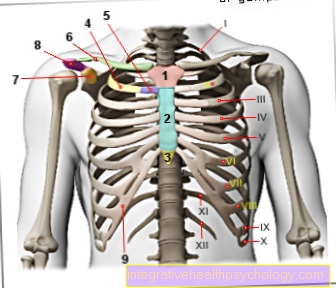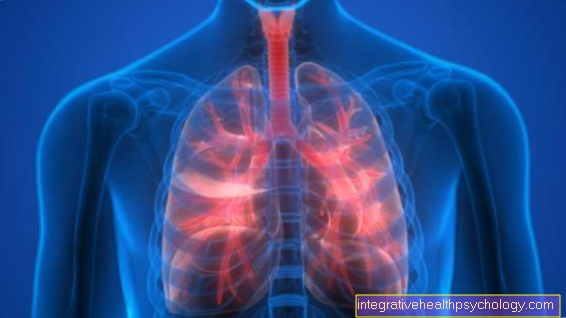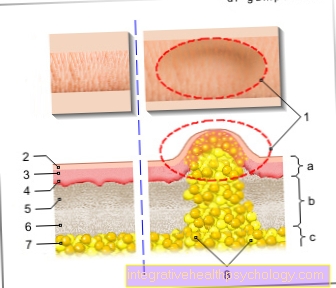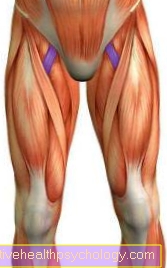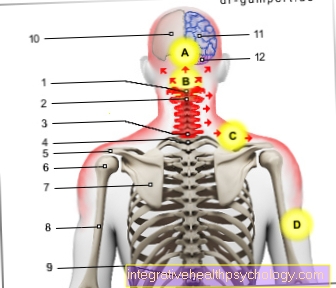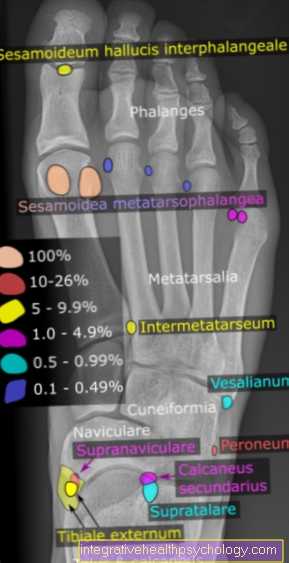Antacids
Synonyms in a broader sense
- Sodium hydrogen carbonate
- Calcium carbonate
- Magnesium carbonate
- Algeldrat
- Hydrotalcite
- Magaldrat
- Maaloxan
- Progastrite
- Ancid
- Megalac
- Talcid
- Riopan
- Simaphil
definition
Antacids (anti = against; Latin acidum = acid) are drugs that bind gastric acid. Antacids are mainly used for heartburn and gastric acid-related complaints. Antacids are a relatively old group of drugs that have evolved over time not only to neutralize stomach acid, but also to protect the gastric mucosa.
Working principle
The effect of acids can be neutralized by adding so-called bases (e.g. antacids). This chemical principle is the basis of the antacid effect. Excess stomach acid (see Reflux disease) is immediately neutralized if an antacid, for example in the form of a tablet, is im stomach arrived. The individual preparations sometimes differ considerably in their acid-binding capacity and the sustainability of their effects.
Info: neutralization capacity
The Neutralization capacity is a measure of the potency of an antacid in order to be able to compare individual preparations in terms of their acid-binding capacity. In package inserts, it is usually given in the unit "mval" (millivalences). A value of 25 meq means that 1 g of active ingredient can neutralize 25 ml of stomach acid. The higher the neutralization capacity, the more effective the preparation.
Applications of antacids
The main area of application for antacids is the symptomatic treatment of mild, occasionally occurring acid-related stomach problems and heartburn. They are available over-the-counter in pharmacies and can be dosed as required. Antacids are available either in solid form as a chewable tablet or in liquid form as a suspension.
If the symptoms are still present after a period of use of 4-8 days, you should consult a doctor to clarify the cause.
Frequent complaints are usually symptoms of an underlying disease that requires treatment. Antacids are therefore not suitable for long-term therapy. But antacids can be used temporarily to relieve acute symptoms without problems until the doctor has initiated a causal therapy. For diseases like Inflammation of the gastric mucosa, Esophagitis or Stomach ulcer, in which a reduction in the acidity of gastric juice is also desired, antacids are rarely used. Here are so-called Proton pump inhibitors meanwhile first choice.
Traditional and modern antacids
The product range of gastric acid binding preparations is diverse. There are single active ingredients and more effective preparations with active ingredient combinations. The effectiveness has been steadily improved over the years and undesirable side effects have been reduced. A modern antacid not only has a high acid binding capacity, but usually also has a protective effect on the mucous membrane. The advantages of using a modern antacid have increasingly ousted traditional preparations from the field of vision.
- Traditional antacids
Active ingredients: e.g. Sodium hydrogen carbonate, calcium carbonate, magnesium carbonate
The active ingredients of traditional antacids are relatively unstable. Their effect occurs in the stomach immediately one. They neutralize existing acid very quickly. As a result, the pH in the stomach rises sharply after taking traditional antacids. However, this is only desirable up to certain values, as otherwise the function of digestive enzymes is impaired.
Info: pH value
Of the PH value is a measure of the acid strength (scale 1-14). The lower the pH, the stronger the acid. In the stomach there is normally a pH value of 1. Antacids reduce the concentration of the acid and thus its irritant effect. This means that irritated and damaged gastric and esophageal mucosa can regenerate faster.
In addition, a pH value that is too high promotes the so-called "Rebound effect". This describes the phenomenon that the stomach is stimulated to increased acid production when the pH value is outside the natural acidic environment (pH 1-5). Modern antacids have a buffer function, i.e. they prevent the pH value from rising to values> 4. This minimizes the rebound effect, the function of the digestive enzymes is not significantly impaired and the acid protection function of the stomach against pathogens is preserved.
A disadvantage of using Carbonates as an antacid is gas evolution. The reaction between carbonates and gastric acid produces carbon dioxide, which as a gas has unpleasant side effects Eructation, Flatulence or Bloating can cause. Modern antacids do not generate any gas. Traditional antacids are still available in pharmacies and drug stores, but are no longer the first choice.
- Modern antacids
Active ingredients: Algeldrat, hydrotalcite, magaldrat
A modern antacid is characterized on the one hand by the fact that it contains several active ingredients. These active ingredients are arranged in layers and give the tablet a particular stability and flexibility in the release of active ingredients. When the stomach acid is neutralized, no gas is released, as is the case with carbonates. In addition, modern antacids only dissolve in the presence of acid. If too little acid is present, no active substance will dissolve. In this way, the pH value is kept constant in a slightly acidic environment so as not to impair the digestive enzymes. One speaks of a buffer effect. The active ingredient is released slowly and only in the amount that is currently needed. Modern antacids thus react more flexibly to acid post-production than traditional active ingredients. These unfold their full effect within a short time and therefore have no lasting effect.
Algeldrat (Trade names including Maaloxan®, Progastrit®)
Algeldrat is another name for hydrous aluminum hydroxide. As an antacid, it is usually combined with magnesium hydroxide. The neutralization of gastric acid does not produce gas, but small amounts of water.Preparations with the active ingredient combination of aluminum and magnesium hydroxide have a neutralization capacity of 25 meq.
Hydrotalcite (Trade names including Ancid®, Megalac®, Talcid®)
Hydrotalcite is a naturally occurring mineral. However, it is made synthetically these days. Hydrotalcite is a mixture of the salts magnesium hydroxide, aluminum hydroxide, carbonate and water. The special feature is the arrangement, one also speaks of a layer lattice structure. The outer layers of the tablet consist alternately of magnesium and aluminum salts. Inside there is carbonate and water. The outer layers gradually react with the stomach acid and neutralize it. The less acid there is, the less soluble the active ingredient. If the acid content in the stomach drops (> pH 4), hardly any active ingredient can be dissolved from the tablet (buffer function). If the stomach produces more acid again, the pH value drops and more active ingredient is dissolved again. This makes hydrotalcid very flexible. Furthermore, hydrotalcite can protect the gastric mucosa, e.g. from harm by NSAIDs. The gastric mucosa contains so-called bicarbonate ions as a protective factor. Hydrotalcite is a bicarbonate ion reservoir and can release it if necessary.
The neutralization capacity of hydrotalcite is 26 meq.
Magaldrat (Trade names including Riopan®, Simaphil®))
Magaldrate is also an active ingredient with a layered lattice structure. It is made up of aluminum and magnesium hydroxide and sulfate ions. Due to its structure, magaldrate, like hydrotalcite, can react very flexibly to the post-production of gastric acid. The neutralization capacity of magaldrat is 22.6 meq.
Instructions for use
Antacids are best taken half an hour to an hour after eating. If you suffer from heartburn at night, it is also recommended to take it before going to bed. The tablet can either be sucked or chewed. It does not make sense to take it before a meal or on an empty stomach, as the active ingredient penetrates too quickly Small intestine gets further where it is ineffective. In the case of acute symptoms, a tablet can also be taken if necessary. You can find more detailed information on the dosage in the package insert or ask for advice from the pharmacy.
Note: taking antacids
In principle, antacids must not be taken together with other drugs! There should be an interval of at least 2 hours between taking antacids and other medications. The order is arbitrary.

